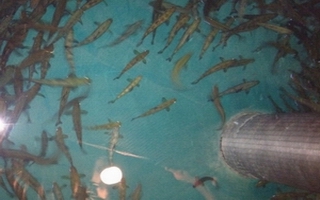
Dunkeld-based FishFrom will this week submit a planning application for the £15 million farm in which the fish will be produced without ever swimming in rivers or the sea.
The farm will be constructed inside a 3.5-acre warehouse at Tayinloan, which will produce 3,000 tonnes of salmon a year – about twice the average sea-based farm. FishFrom plans to ship out 800,000 salmon a year from the site, supplying retailers such as Marks and Spencer, Waitrose and Youngs Seafood. It already supplies Heston Blumenthal’s Michelin-starred restaurant in Berkshire, The Fat Duck, with farmed trout. The company has plans for another onshore farm on the Scottish mainland and hopes to role out the model worldwide in a bid to meet the growing demand for artificially raised fish.
“Closed containment” systems have the backing of the Perth-based conservation body Atlantic Salmon Trust (AST), which is leading moves to save wild salmon from being wiped out in Scotland’s rivers, because of their perceived environmental benefits. The trust’s patron is Prince Charles.
Scotland’s sea-loch based salmon-farming industry has faced criticism that it pollutes the environment and damages stocks of wild salmon. Onshore farms remove the threat of mass escapes caused by storm damage to offshore cages.
The fish will be grown from the smolt stage – about 50 grammes – into 5kg adults in nine months in tanks through which 32 million litres of fresh and sea water will be pumped every hour. To make the farm economically viable, the tanks will be stocked with twice the density of fish found in conventional farms. The plan is to run the facility on largely green energy, with solar panels and a hydro scheme nearby
Fish are farmed in closed containment facilities in Spain, Denmark, the Netherlands, Ireland, north America and China, but FishFrom director Andrew Robertson says the Tayinloan facility will be the biggest so far. “We have carried out extensive feasibility studies and completed our business plan. This will be the largest onshore salmon farm in the world,” said Robertson.
“We already have an international company that supplies prawns direct to Marks and Spencer and they say they will take everything we produce. We also have other customers in France and the UK lined up. We plan to start operations next year. The £15m will take it through to its first year of harvesting. But the farm will produce £12m of sales annually.
“We will feed our fish on pellets made from ragworms, algae and amino acids instead of taking fish out of the sea to make fish meal. The waste from the salmon will be turned into fertiliser instead of clogging up the ocean.”
Robertson said he had encountered resistance from the Scottish Salmon Producers’ Organisation (SSPO) – which represents most of the conventional sea fish farmers. “This is about literally a sea-change in thinking,” Robertson said. “But with closed containment, the overall costs are reduced considerably as well as the cost to the environment. We don’t have to deal with sea lice, seals or storms. Closed containment is going to be a big part of the future.”
The AST outlined its support for closed containment systems in its annual review. It says such techniques can reduce the “industrial scale exploitation of the seas” and lead to less wild salmon being killed. Chief executive Tony Andrews said problems remain in conventional aquaculture and that in places “the impacts on the environment and wildlife are unacceptably high”.
“This valuable industry, in terms of jobs and revenue, as well as its contribution to removing the pressure from killing wild salmon, deserves our support,” Andrews said.
“The problem is that salmon farming as currently practised has been shown to damage the environment and wildlife in certain locations in both fresh and salt water. For AST this issue is a major challenge because, while we recognise the achievements of the industry in terms of the economic and social boost it has provided to local communities, we know that it cannot continue as it is.”
Production of farmed fish in Scotland is about 158,000 tonnes per year and artificially reared salmon is the nation’s largest food export.
Despite the demand, the SSPO is sceptical about the industry expanding onshore. A spokesman said: “A recent critical review of closed containment systems concluded they do not offer adequate advantages to the Scottish salmon sector. The many disadvantages that were highlighted included higher levels of energy, greater environmental footprint, higher stocking densities, higher level of capital and operating costs and higher prices for the consumer.”
Animal welfare groups said they had concerns. Libby Anderson, policy director for Edinburgh-based One Kind, said: “Salmon are a migratory species who by their nature travel thousands of miles in their lifetime. We can’t see how closed containment overcomes that issue.”





